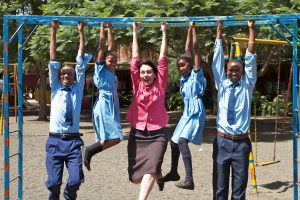 My first overseas trip was at the age of two months when Mum and I travelled by boat from Sydney with all our belongings to join Dad who was then working as an agricultural scientist in Papua New Guinea.
My first overseas trip was at the age of two months when Mum and I travelled by boat from Sydney with all our belongings to join Dad who was then working as an agricultural scientist in Papua New Guinea.
For the next 18 years the family, eventually with three daughters, moved around the country and my mother remembers that, as a small child, this traumatized me – I hated change, hated moving and screamed every time I saw a suitcase.
I must have got over it quickly as I haven’t stopped traveling since.
As I look back on my decades of circling the globe, I realize I have probably experienced all types of traveling styles.
In my early 20s I was a travel agent – the best job for the travel-obsessed. That meant (in the good old days!) that I regularly traveled first class and stayed for free in the best room in the hotel, enjoying complimentary … well, everything, really.
My work enabled me to travel as a wealthy tourist and I loved it. I saw the world, or small parts of it, from the 23rd floor of high-rise city hotels, lazing beside lagoon-style swimming pools in luxury resorts, through tinted windows of limousines and peering down from sumptuous seat No 3A on a Qantas jet.
I enjoyed the allure, excitement and intoxication of being surrounded by glamorous jet-setters in exotic locations.
Then in my late 20s I moved to London and played on the periphery of the West End theatre scene. This translated into a serious adjustment to my spending habits – wardrobe courtesy of end-of-season sales and second-hand stores (hey, it was London in the 70s so that was easy!) and bargain-basement everything else, including travel.
I discovered backpacks, sensible walking shoes and small packs of toiletries I had to buy myself.
I bunked in hostel rooms with strangers’ sweaty gym shoes in Vietnam; clung to the back of a rusty truck for a death-defying trip on back roads in Ecuador; ate indiscernible foodstuffs from roadside shacks in Malaysia, and slept on the middle bunk of six in the couchette in France.
Fellow travelers shared maps, snacks, shampoo, travel tales and tips on the cheapest way to get to the next ‘must see’ local attraction.
I did have an episode of what could be called ego-tourism when I headed to Buenos Aires to board a ship for the three-week trip to the Antarctic. I must admit I enjoyed hearing the envy in people’s voices when I casually mentioned my travel plans!
Of all the adventures I have had so far, none has fulfilled me as much as traveling and working as a voluntourist in Africa.
I made a chance comment to a friend, eleven years ago.
“I’m over working long, stress-filled days in the corporate world, where the beneficiaries are those with already stuffed wallets.”
I told her I would rather my efforts aided those less fortunate.
“Well, maybe Gemma Rice could do with a hand,” she said.
That is how I discovered a small school with two classrooms, nine students and one teacher in the village of Arusha, Northern Tanzania. Gemma Rice (now Sisia) was the determined young Aussie woman who started the school to fulfill her dream of a free, quality education for the poorest kids in the district.
I rolled up my jeans and mucked in wherever there was a need and discovered I had previously untapped skills such as digging ditches, planning classroom blocks, employing and managing staff, dealing with government departments, negotiating contracts and writing promotional material.
The challenges were huge; the rewards, enormous.
I honed my patience, tolerance, perseverance, determination and sense of humor – the greatest requirements needed to ensure the success of a project in a developing country.
I embraced life in a new culture and learned to cope with the drawbacks of intermittent electricity and water, bucket showers, drop-hole toilets and no TV or internet (unless I hitchhiked to the Internet café in town, knowing that there might be no electricity, anyway).
In those days Arusha had no coffee shops, cinemas or supermarkets.
I learned to do without balsamic vinegar on my homegrown tomatoes and the only news I needed was the fact that we had a few more donations to build another classroom. What was happening in the rest of the world seemed irrelevant. Corporate fraud, pregnant superstars and the Blues losing the State of Origin seemed to be happening on another planet.
The School of St Jude is now one of Africa’s largest schools of its kind (funded by donations and offering a free, quality education to over 1,600 disadvantaged kids). I’m proud to have had a part in making this a success story.
Kim Saville is the Director of International Relations for The School of St Jude, a role in which she travels as intensively as ever to attract support for the school.





Leave a Reply